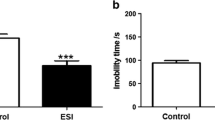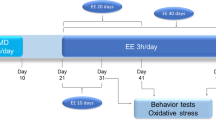Abstract
Evidence indicates that experiencing early-life stress (ELS) is a risk factor for the development of mental disorders such as depression. Maternal separation stress (MS) is a valid animal model of ELS that caused to induce long-lasting effects on the brain and behaviors of animals. It hypothesized that adolescence is a critical stage in which the brain is still developing, and applying (non)pharmacological therapies in this period may attenuate the effects of ELS on the brain and behavior. Male rats were subjected to MS from postnatal day (PND) 2–14, and the stressed animals were then treated with (1) chronic fluoxetine (FLX) (5 mg/kg) and (2) voluntary running wheel exercise (RW) from PND 30, for 30 days. Then, we subjected the animals to behavioral and molecular assessments at PND 60. Our data showed that MS provoked depressive-like behaviors in rats, tested by the forced swimming test, splash test, and sucrose preference test. Additionally, we found that MS increased the gene expression of the NR2A (and not NR2B) subunit of N-methyl-d-aspartate (NMDA) receptors in the hippocampus of adult rats. Both FLX and RW treatments during adolescence were able to mitigate the negative effects of ELS on stressed animals. These results highlighted the importance of adolescence in treating stressed animals with FLX/voluntary RW exercise to alleviate the depressive effects of ELS. In addition, we found that ELS altered the transcriptional level of Grin2a (and not Grin2b) in the hippocampus. Finally, our results showed that FLX/voluntary RW exercise during adolescence could normalize altered expression of Grin2a in the hippocampus of adult rats.





Similar content being viewed by others
References
Lupien SJ et al (2009) Effects of stress throughout the lifespan on the brain, behaviour and cognition. Nat Rev Neurosci 10(6):434
Heim C, Binder EB (2012) Current research trends in early life stress and depression: review of human studies on sensitive periods, gene–environment interactions, and epigenetics. Exp Neurol 233(1):102–111
Millstein RA, Holmes A (2007) Effects of repeated maternal separation on anxiety-and depression-related phenotypes in different mouse strains. Neurosci Biobehav Rev 31(1):3–17
Kessler RC, Magee WJ (1993) Childhood adversities and adult depression: basic patterns of association in a US national survey. Psychol Med 23(3):679–690
Serafini G et al (2014) Hippocampal neurogenesis, neurotrophic factors and depression: possible therapeutic targets? CNS Neurol Disord Drug Targets 13(10):1708–1721
Sanacora G et al (2008) Targeting the glutamatergic system to develop novel, improved therapeutics for mood disorders. Nat Rev Drug Discov 7(5):426
Manji HK, Drevets WC, Charney DS (2001) The cellular neurobiology of depression. Nat Med 7(5):541
Parsons MP, Raymond LA (2014) Extrasynaptic NMDA receptor involvement in central nervous system disorders. Neuron 82(2):279–293
Lau CG, Zukin RS (2007) NMDA receptor trafficking in synaptic plasticity and neuropsychiatric disorders. Nat Rev Neurosci 8(6):413
Paoletti P, Bellone C, Zhou Q (2013) NMDA receptor subunit diversity: impact on receptor properties, synaptic plasticity and disease. Nat Rev Neurosci 14(6):383
Jiménez-Sánchez L et al (2014) The role of GluN2A and GluN2B subunits on the effects of NMDA receptor antagonists in modeling schizophrenia and treating refractory depression. Neuropsychopharmacology 39(11):2673
Anderson IM (2000) Selective serotonin reuptake inhibitors versus tricyclic antidepressants: a meta-analysis of efficacy and tolerability. J Affect Disord 58(1):19–36
Masand PS, Gupta S (2002) Long-term side effects of newer-generation antidepressants: SSRIS, venlafaxine, nefazodone, bupropion, and mirtazapine. Ann Clin Psychiatry 14(3):175–182
Ströhle A (2009) Physical activity, exercise, depression and anxiety disorders. J Neural Transm 116(6):777
Peeri M, Amiri S (2015) Protective effects of exercise in metabolic disorders are mediated by inhibition of mitochondrial-derived sterile inflammation. Med Hypotheses 85(6):707–709
Vetulani J (2013) Early maternal separation: a rodent model of depression and a prevailing human condition. Pharmacol Rep 65(6):1451–1461
Sadeghi M, Peeri M, Hosseini M-J (2016) Adolescent voluntary exercise attenuated hippocampal innate immunity responses and depressive-like behaviors following maternal separation stress in male rats. Physiol Behav 163:177–183
Daniels WM et al (2012) Exercise normalizes altered expression of proteins in the ventral hippocampus of rats subjected to maternal separation. Exp Physiol 97(2):239–247
Voss MW et al (2013) Bridging animal and human models of exercise-induced brain plasticity. Trends Cogn Sci 17(10):525–544
Venezia AC et al (2016) Sex-dependent and independent effects of long-term voluntary wheel running on BDNF mRNA and protein expression. Physiol Behav 156:8–15
Redila V, Christie B (2006) Exercise-induced changes in dendritic structure and complexity in the adult hippocampal dentate gyrus. Neuroscience 137(4):1299–1307
Stranahan AM, Khalil D, Gould E (2007) Running induces widespread structural alterations in the hippocampus and entorhinal cortex. Hippocampus 17(11):1017–1022
Goldapple K et al (2004) Modulation of cortical-limbic pathways in major depression: treatment-specific effects of cognitive behavior therapy. Arch Gen Psychiatry 61(1):34–41
Amiri S et al (2016) Involvement of D1 and D2 dopamine receptors in the antidepressant-like effects of selegiline in maternal separation model of mouse. Physiol Behav 163:107–114
Der-Avakian A et al (2014) Enduring deficits in brain reward function after chronic social defeat in rats: susceptibility, resilience, and antidepressant response. Biol Psychiatry 76(7):542–549
Miladi-Gorji H, Rashidy-Pour A, Fathollahi Y (2012) Anxiety profile in morphine-dependent and withdrawn rats: effect of voluntary exercise. Physiol Behav 105(2):195–202
Sonei N et al (2017) Mitochondrial dysfunction bridges negative affective disorders and cardiomyopathy in socially isolated rats: pros and cons of fluoxetine. World J Biol Psychiatry 18(1):39–53
Porsolt RD et al (1978) Behavioural despair in rats: a new model sensitive to antidepressant treatments. Eur J Pharmacol 47(4):379–391
Haj-Mirzaian A et al (2016) Lithium attenuated the depressant and anxiogenic effect of juvenile social stress through mitigating the negative impact of interlukin-1β and nitric oxide on hypothalamic–pituitary–adrenal axis function. Neuroscience 315:271–285
Marrocco J et al (2014) The effects of antidepressant treatment in prenatally stressed rats support the glutamatergic hypothesis of stress-related disorders. J Neurosci 34(6):2015–2024
Wallace DL et al (2009) CREB regulation of nucleus accumbens excitability mediates social isolation–induced behavioral deficits. Nat Neurosci 12(2):200
Cryan JF, Holmes A (2005) The ascent of mouse: advances in modelling human depression and anxiety. Nat Rev Drug Discov 4(9):775–790
Willner P et al (1987) Reduction of sucrose preference by chronic unpredictable mild stress, and its restoration by a tricyclic antidepressant. Psychopharmacology 93(3):358–364
Rygula R et al (2005) Anhedonia and motivational deficits in rats: impact of chronic social stress. Behav Brain Res 162(1):127–134
Aisa B et al (2007) Cognitive impairment associated to HPA axis hyperactivity after maternal separation in rats. Psychoneuroendocrinology 32(3):256–266
El Khoury A et al (2006) Adult life behavioral consequences of early maternal separation are alleviated by escitalopram treatment in a rat model of depression. Prog Neuropsychopharmacol Biol Psychiatry 30(3):535–540
Réus GZ et al (2015) Ketamine ameliorates depressive-like behaviors and immune alterations in adult rats following maternal deprivation. Neurosci Lett 584:83–87
Uysal N et al (2015) Effects of voluntary and involuntary exercise on cognitive functions, and VEGF and BDNF levels in adolescent rats. Biotech Histochem 90(1):55–68
Gardoni F et al (2001) Hippocampal synaptic plasticity involves competition between Ca2+/calmodulin-dependent protein kinase II and postsynaptic density 95 for binding to the NR2A subunit of the NMDA receptor. J Neurosci 21(5):1501–1509
Boyce-Rustay JM, Holmes A (2006) Genetic inactivation of the NMDA receptor NR2A subunit has anxiolytic-and antidepressant-like effects in mice. Neuropsychopharmacology 31(11):2405
Karolewicz B et al (2009) Elevated levels of NR2A and PSD-95 in the lateral amygdala in depression. Int J Neuropsychopharmacol 12(2):143–153
Lee PR, Brady D, Koenig JI (2003) Corticosterone alters N-methyl-D-aspartate receptor subunit mRNA expression before puberty. Mol Brain Res 115(1):55–62
Norcross M et al (2008) Effects of adolescent fluoxetine treatment on fear-, anxiety-or stress-related behaviors in C57BL/6J or BALB/cJ mice. Psychopharmacology 200(3):413
Ganguly P, Holland FH, Brenhouse HC (2015) Functional uncoupling NMDAR NR2A subunit from PSD-95 in the prefrontal cortex: effects on behavioral dysfunction and parvalbumin loss after early-life stress. Neuropsychopharmacology 40(12):2666
Manatos V, Stylianopoulou F, Stamatakis A (2016) The levels of the GluN2A NMDA receptor subunit are modified in both the neonatal and adult rat brain by an early experience involving denial of maternal contact. Neurosci Lett 612:98–103
Sun H et al (2013) Involvement of NR1, NR2A different expression in brain regions in anxiety-like behavior of prenatally stressed offspring. Behav Brain Res 257:1–7
Amiri S et al (2016) NMDA receptor antagonists attenuate the proconvulsant effect of juvenile social isolation in male mice. Brain Res Bull 121:158–168
De Bellis MD et al (2000) Hippocampal volume in adolescent-onset alcohol use disorders. Am J Psychiatry 157(5):737–744
Crews F, He J, Hodge C (2007) Adolescent cortical development: a critical period of vulnerability for addiction. Pharmacol Biochem Behav 86(2):189–199
Andersen SL, Teicher MH (2004) Delayed effects of early stress on hippocampal development. Neuropsychopharmacology 29(11):1988
Gomes da Silva S et al (2012) Early exercise promotes positive hippocampal plasticity and improves spatial memory in the adult life of rats. Hippocampus 22(2):347–358
Abel JL, Rissman EF (2013) Running-induced epigenetic and gene expression changes in the adolescent brain. Int J Dev Neurosci 31(6):382–390
Author information
Authors and Affiliations
Corresponding author
Rights and permissions
About this article
Cite this article
Masrour, F.F., Peeri, M., Azarbayjani, M.A. et al. Voluntary Exercise During Adolescence Mitigated Negative the Effects of Maternal Separation Stress on the Depressive-Like Behaviors of Adult Male Rats: Role of NMDA Receptors. Neurochem Res 43, 1067–1074 (2018). https://doi.org/10.1007/s11064-018-2519-6
Received:
Revised:
Accepted:
Published:
Issue Date:
DOI: https://doi.org/10.1007/s11064-018-2519-6




